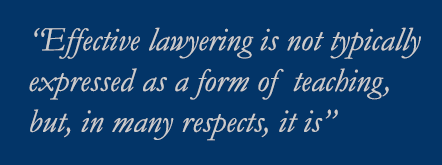Lawyers have to persuade but before they can they have to communicate; that is, they have to teach. Effective lawyering is not typically expressed as a form of teaching, but, in many respects, it is: the best lawyers can in some sense be looked at as simply the most effective teachers. They make the complex comprehensible, and enable others to understand key facts and ideas which support their side of the case.
Many believe that substance alone dictates results, and that the non-verbal aspects of communicating an idea are not as essential as the actual message being conveyed. But effective teaching implicates both the verbal and non-verbal, including the use of “paralanguage” and “metamessage.”
Paralanguage. “Paralanguage is the vocal component of speech, considered apart from the verbal content. It includes pitch, resonance, articulation, tempo, volume, and rhythm. Through  paralanguage you unintentionally betray your moods and attitudes. No matter what you say, the sound of how you say it will reveal a great deal about who you are and what you feel.”[1]
paralanguage you unintentionally betray your moods and attitudes. No matter what you say, the sound of how you say it will reveal a great deal about who you are and what you feel.”[1]
Metamesssage. “Many statements have two levels of meaning. One level is the basic information being communicated by a series of words. The second level, or metamessage, communicates the speaker’s attitudes and feelings. The metamessage is largely communicated by rhythm, pitch, and verbal modifiers…A sentence in which each word gets equal emphasis is unlikely to contain a metamessage. But accentuating one or more of the words, the speaker communicates a great deal about his or her emotional state.”[2]
A recent article on teaching describes the importance of non-verbal methods such as these: “Non-verbal communication includes all aspects of communication except the use of words. In other words, non-verbal communication includes not only gestures and movements of the body but also the way that the words are expressed, such as the music of the words, interruptions, loudness and accents; these non-verbal features affect the meaning of words.” “Therefore, by the use of this language, interests, emotions, and feeling could be expressed well. In other words, there are other eloquent languages in the silent and quiet world, the knowledge of which is very helpful in effective communication.”[3]
What are these “other eloquent languages in the silent and quiet world?” We are of course taught spoken English, but no one is ever taught unspoken English. Such a language has its own unique vocabulary, one acquired through practice and experience, and is best recognized as being as essential as language itself. But no one ever explained the importance of mastering this silent language…why wasn’t this emphasized? Language and paralanguage actually are two halves of a single competence––one is imperfect and incomplete without the other.
What does this imply? It implies that no small degree of attention should be given to paralanguage and metamessage in any speaking situation––to prepare adequately entails not only preparing what will be said, but how it will be said. “In the selection of words, the intended concept must be exactly in the words of the educator. It is appropriate to use clear, concise, accurate, polite, correct and rich expression in oral communication with the audience to transmit the speaker’s intentions to the audience properly.”[4]
[1] Matthew McKay, Martha Davis, Patrick Fanning, Messages: The Communication Skills Book, Pg. 63 (New Harbinger Publications, Inc. 1995).
[2] Id. at 67.
[3] Fatemeh Bambaeeroo, Nasrin Shokrpour, The impact of the teachers’ non-verbal communication on success in teaching, J. Adv Med Educ Prof 2017 April; 5(2) 51-59.
[4] Id.




